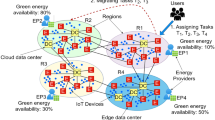Abstract
There has been a great deal of recent research interest regarding the storage and utilization of big data via remote cloud platforms. The efficiency of large data transfers from remote cloud platforms is a critical issue, and dedicated networks are used for data transfer. To resolve the data transfer efficiency issue, it is necessary to tune the L2-related performance items in the transport equipment and to regulate performance factors, such as window size, between IP layer servers, during the configuration of an end-to-end research network. It is also necessary to tune factor values related to performance items in transport equipment. System level kernel parameter tuning is also needed and results in improved throughput. Here, we measure throughput according to L2-related tuning factors and IP levels, including kernel parameter turning, and present an analysis of the measurement results. The experimental results show that end-to-end servers with tuned factors, in addition to system level kernel parameter tuning, can effectively utilize the available bandwidth.







Similar content being viewed by others
References
Dart E, Rotman L, Tierney B, Hester M, Zurawski J (2014) The science DMZ: a network design pattern for data. Sci Program 22(2):173–185
Monga I, Pouyoul E, Guok C (2012) Software-defined networking for big-data science-architectural models from campus to the WAN. In: Proceedings of SCC, Salt Lake City, UT
Maity S, Park J (2016) Powering IoT devices: a novel design and analysis technique. J Converg 7(2):1–10
Azodolmolky S, Wieder P, Yahyapour R, Rollins S (2013) Cloud computing networking: challenges and opportunities for innovations. IEEE Commun Mag 51(7):54–62
Vogel A, Griebler D, Schepke C, Fernandes LG (2017) An intra-cloud networking performance evaluation on cloudstack environment. In: Proceedings of PDP
Alexey G, Parygin DS, Finogeev AA (2017) The convergence computing model for big sensor data mining and knowledge discovery. Hum Centric Comput Inf Sci 7(1):11
Kar J, Mishra MR (2016) Mitigating Threats and security metrics in cloud computing. J Inf Process Syst 12(2):133–226
Banerjee N, Sorber J, Corner M, Rollins S, Ganesan D (2005) Triage: a power-aware software architecture for tiered microservers. Technical report. University of Massachusetts-Amherst, pp 5–22
Burns B, Brock O, Levine BN (2005) MV routing and capacity building in disruption tolerant networks. In: Proceedings of IEEE INFOCOM, pp 398–408
Qiu L, Chandra R, Jain K, Mahdian M (2004) Optimizing the placement of integration points in multi-hop wireless networks. In: Proceedings of ICNP, pp 271–282
Liu JB, Mannemela P (2005) Internet2 end to end performance tuning for distributed computing applications. In: Proceedings of ICIT
Huang J, Wang J, Zhang T, Chen J, Pan Y (2016) Tuning the aggressive TCP behavior for highly concurrent HTTP connections in data center. In: Proceedings of ICDCS
Kailbach W, Ilchmann F (2010) Multi service OTN design and optimization of a Germany wide scale example network. In: Proceedings of Photonic Networks
Heinanen J, Guerin R (1999) A two rate three color marker. RFC 2698
Luo J, Yang X, Xu J, Sun J (2016) AAIC: adaptive-sliding-connection-window solution to TCP incast from application layer. IEEE Commun Lett 20(10):1967–1970
Jung H, Kim S, Yeom H, Kang S, Libman L (2015) Adaptive delay-based congestion control for high bandwidth-delay product networks. In: Proceedings of INFOCOM
Yue Z, Zhang X, Ren Y, Li J, Zhong Q (2012) The performance evaluation and comparison of TCP-based high-speed transport protocols. In: Proceedings of ICSESS
Liu A, Wu B, Hao Y, Zhao N, Yin H (2011) Design and development of adaptive-generalized optical transceiver module with multi-rates supporting SONET, SDH and Gigabit-Ethernet, In: Proceedings of OECC
Hamad A, Kadoch M (2015) SONET over Ethernet. In: Proceedings of GOCICT
Jimenez T, Lopez V, Jimenez F, Dios OG, Fernandez-Palacios JP (2016) Techno-economic evaluation of optical transport network in metropolitan deployments. In: Proceedings of ECOC
Author information
Authors and Affiliations
Corresponding author
Additional information
This research was supported by Korea Institute of Science and Technology Information (KISTI).
Rights and permissions
About this article
Cite this article
Lee, WH., Park, JS., Kim, SH. et al. A method for enhancing end-to-end transfer efficiency via performance tuning factors on dedicated circuit networks with a public cloud platform. J Supercomput 74, 1255–1266 (2018). https://doi.org/10.1007/s11227-017-2157-9
Published:
Issue Date:
DOI: https://doi.org/10.1007/s11227-017-2157-9




